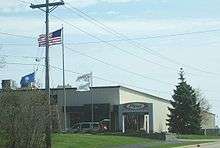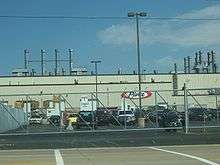Pierce Manufacturing
Pierce Manufacturing is an American, Appleton, Wisconsin-based manufacturer of custom fire and rescue apparatus and a wholly owned subsidiary of Oshkosh Corporation. Pierce was acquired by Oshkosh in 1996 and is currently the largest fire apparatus company in the world. The company was founded in 1913 by Humphrey Pierce and his son Dudley as the Pierce Auto Body Works Inc., and concentrated on building custom truck bodies for the Ford Model T. The first production facility was designed in 1917 and enlarged in 1918 by architect Wallace W. DeLong.[1] From the 1960s to the early 1980s, Pierce was primarily known for building custom bodies on commercial and other manufacturer's custom chassis, and was considered an original equipment manufacturer (OEM).
| Subsidiary of Oshkosh | |
| Industry | Trucks & Other Vehicles |
| Founded | 1913 |
| Headquarters | Appleton, Wisconsin, U.S.A. |
Key people | Jim Johnson, President Mike Pack, CFO |
| Products | Fire and Rescue Vehicles |
| Revenue | |
Number of employees | 2100 |
| Parent | Oshkosh Corporation |
| Website | www.piercemfg.com |


Although the Arrow name was used for its first custom chassis which debuted in 1979, the company has no affiliation with George N. Pierce's famous Pierce-Arrow Motor Car Company of Buffalo, New York, which operated from 1901 to 1938. However, the Pierce-Arrow Motor Car Company coincidentally supplied 8- and 12-cylinder engines to Seagrave for use in their fire apparatus. These engines continued to be made even after Pierce-Arrow ceased operation in 1938. Seagrave continued to deliver fire apparatus with the "Pierce-Arrow" V-12 until 1970.
Throughout the years, Pierce has had partnerships with various other manufacturers, notably when it came to aerial devices (it now engineers and builds all its own aerial devices in-house). Such aerial manufacturers included Snorkel, Pitman, Aerial Innovations (AI), Ladder Towers Incorporated (LTI), Smeal, Bronto Skylift and Nova Quintech (whose assets Pierce/Oshkosh acquired in 1997). In addition to its main facilities in Wisconsin, it also has facilities in Bradenton, Florida. The Florida facility is a manufacturing site for the custom Saber chassis and Responder line of apparatus. Currently (December 4, 2017) Pierce is the largest manufacturer of firefighting apparatus. End-users are represented across a larger majority of the planet, including China. The single largest municipal fleet of Pierce Manufacturing apparatus is located within the 407 square miles of Fairfax County, Virginia. (Fairfax County Fire and Rescue Department)
Innovations
Pierce is noted for leading the way in fire apparatus innovations, including:
- First custom tilt cab (Dash, 1984) and custom split-tilt cab (Lance, 1985) in the industry
- Command Zone fully multiplexed chassis and aerial devices (1996)
- TAK-4 independent front suspension (2001)
- Side Roll Protection System side airbags (2003)
- Front airbags (2006)
- PUC (2007) In 2007, the way the pump sits on the apparatus was redesigned to:
- Reduce operational steps
- Improve operation safety
- Provides easier access for servicing
- Improve compartment organization
- Add compartment space
- Optimize design flexibility
- Shorten the wheelbase
- Increased tank size
- Ascendant 107' aerial quint on a single rear axle.
Products
Custom chassis
Current
Discontinued

- Arrow (1980–2002)
- Dash (1984–1999)
- Dash D-8000 (1988–1992)
- Dash 2000 (1999–2007)
- Enforcer (2000–2007)(Reintroduced in 2014)
- Javelin (1990–1993)
- Lance (1985–1993)
- Lance II (1993–1999)
- Lance 2000 (1999–2007)
- Contender custom (1999–2010)
Commercial chassis
- Suburban (????–????)
- Contender Commercial (1999–current)
- Responder (?-1998)(Reissued 2008–current)
Apparatus
- Rearmount and midmount steel aerial ladders and quints
- Rearmount aluminum aerial ladders and quints
- Rearmount and midmount steel aerial platforms and quints
- Rearmount aluminum aerial platforms
- Tractor drawn steel aerial ladders and quints
- Telescoping and/or articulating water tower booms
- Standard, rescue, and heavy duty rescue midship mount pumpers
- Rear mount rescue pumpers
- Mini pumpers
- Pumper tankers/tenders and elliptical tankers/tenders
- Wildland/brush pumpers
- Walk-in and non-walk-in heavy rescues
- Homeland security vehicles
- Command and communication vehicles
- Foam systems
- Fire Patrol Trucks
Gallery
- Engine 55 of the Greenfields Fire Co, PA. 1999 Pierce Quantum Pumper
 6-Tower of the Hillcrest Fire Co. #1, NY. 2002 Pierce Dash 2000 95' Midmount Aerial Platform Quint
6-Tower of the Hillcrest Fire Co. #1, NY. 2002 Pierce Dash 2000 95' Midmount Aerial Platform Quint Reserve Engine 249 of the Clay Fire Territory, IN. 1985 Pierce Dash Pumper
Reserve Engine 249 of the Clay Fire Territory, IN. 1985 Pierce Dash Pumper- Reserve Ladder 18 serving the Lexington Fire Department, KY. Pierce Arrow 105' X-Ladder 1
_105'_Pierce_Arrow.jpg) Aerial 1 serving the Jackson Fire Department, KY. 1988 Pierce Arrow 105' canopy cab
Aerial 1 serving the Jackson Fire Department, KY. 1988 Pierce Arrow 105' canopy cab- Engine 14 serving the Crab Orchard Fire Department, KY. 2006 Pierce Contender custom cab
- Engine 30 serving the Stanton Fire Department, KY. 2002 Pierce Contender-Freightliner crew cab
- Engine 2 serving the Jackson Fire Department, KY. 2003 Pierce Contender-Kenworth single cab
- Engine 10 serving the Morehead Fire Department, KY. 2005 Pierce Enforcer with Roto Ray
- Engine 8 serving the Morehead Fire Department, KY. 1993 Pierce Responder-International crew cab
- Engine 3 serving the West Liberty Fire Department, KY. 1993 Pierce Responder-International single cab
- Engine 7 serving the Morehead Fire Department, KY. 1979 Pierce-Hendrickson custom cab
References
- "Appleton". The American Contractor. August 18, 1917.
- Shapiro, L. Aerial Fire Trucks, Motorbooks International, June 2002. ISBN 0-7603-1065-3
- Company History
External links
| Wikimedia Commons has media related to Pierce vehicles. |